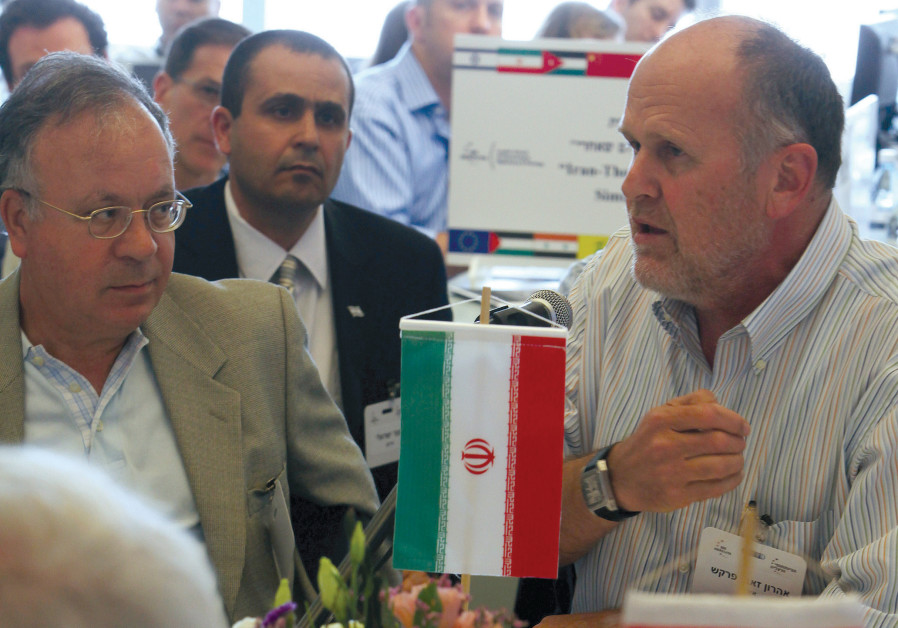‘Minority Report’ targeted killings of terrorists by 2025 – ex-IDF chief

FORMER IDF intelligence chief Aharon Zeevi Farkash (right), playing Iran, sits with experts during an Iran wargame in Herzliya in 2010. (photo credit: REUTERS/NIR ELIAS)
By 2025, 10,000 satellites will provide constant Israeli video surveillance of the Middle East sufficient to carry out targeted killings of terrorists at any time and any place, former IDF intelligence chief Aharon Zeevi Farkash said on Wednesday.
Zeevi Farkash, who led Military Intelligence from 2001 to 2006, was speaking at an intelligence conference in Tel Aviv that also included former top Mossad and Shin Bet (Israel Security Agency) officials, and was sponsored by the Intelligence Inheritance and Commemoration Center and the Israel Defense magazine.
The former IDF intelligence chief made several other observations about important trends in intelligence and technology.
Israel’s intelligence capabilities are moving so fast that soon they may reach a point where it can turn all oral communications that it has picked up immediately into digital form, he said.
Furthermore, Israeli intelligence will then be able to forward the data in specific customized formats for immediate use by the air force, navy and ground forces.
While praising Israeli intelligence efforts, he said one area where intelligence abilities are lagging compared to security needs is in sufficiently multiplying ground forces capabilities, Zeevi Farkash said.
While Israel “has supremacy in the air, it lacks supremacy in ground warfare. We will not be able to stop rockets against us until we gain ground warfare supremacy,” including improved delivery of intelligence to operations in the field, he said.
Other speakers at the conference, such as former senior Shin Bet official Adi Carmi, also referred to some of Israeli intelligence’s mind-boggling capabilities, though he emphasized human intelligence gathering.
During the 2014 Gaza war (Operation Protective Edge), Israel hit around 350 targets where it used primarily intelligence gathered by human assets to locate terrorists, locate their neighbors to warn them to leave before an attack and procured all the neighbors telephone numbers in order to warn them, he said.
Jumping to the present, Carmi said that during the Gaza border confrontations on Monday, Israeli intelligence knew in advance that at least “50% of those arriving were Hamas and Islamic Jihad.
We knew their names, we knew who was bringing explosives… intelligence collection gets as intimate as you get.”
Former senior Shin Bet official Barak Ben Tzur gave a wide historical view of what he called a “revolution” in which targeted killings using advanced technology to locate terrorists and to get the right weaponry to the right place to strike them replaced creative options used in earlier decades – such as a cigarette lighter doubling as a gun.
He marveled at the ability to transfer information so that much of the raw data can reach the political decision-makers and they can get their orders quickly and directly to commanders in the field.
Ben Tzur said this skipped what once would have been an in-between vetting process within the intelligence establishment about what to share with the political echelon, which meant that some senior intelligence officials had lost some control, but also meant an ability to strike with less delay.
German military intelligence chief Georg Miarka spoke at the conference about his country being on track to “fully digitizing all land forces and related intelligence by 2032.”
These efforts will include integrating automation, artificial intelligence and robotics into German ground forces, he said.
While Miarka admitted this move would expose Germany to more cyberattacks, he said it was an important move and such that his country must also strengthen its counter-intelligence capabilities and backup plans in case its systems are hacked.
Miarka also said that a range of new networked systems were already introduced by German military intelligence last year and had already been used successfully in multinational peacekeeping missions in Afghanistan, Mali and the Balkans.
Military Intelligence Col. “Y.” presented the latest big data trends in IDF intelligence, including its new approaches to using artificial intelligence and deep machine learning, and building a new kind of team around those concepts.





Comments are closed.